Looking Ahead
Volume 62 Number 19 Date 11/09/2017
PEST HIGHLIGHTS OF 2017
CORN ROOTWORM - Beetle counts in August were the lowest in 47 years of annual surveys. The 2017 state average of 0.2 beetle per plant was a substantial decrease from last year's moderate average of 0.5 per plant and the lowest since surveys for adult corn rootworms began in Wisconsin in 1971. Excessive spring rain during egg hatch, continued high use of pyramided Bt-rootworm (Bt-RW) corn, and the layering of soil insecticides on Bt-RW hybrids at planting likely influenced this year's historically low beetle populations.
BROWN MARMORATED STINK BUG - Established populations of this invasive pest now occur in at least five Wisconsin counties. Dane and Rock have been generally infested for 2-5 years, while Brown, Jefferson and Waukesha counties were added to the list in 2017. Citizen reports indicate the actual distribution of brown marmorated stink bug (BMSB) in the state is much wider. Specimens have been confirmed by the UW and DATCP from 20 counties since 2010, with most reports concentrated near Madison, Waukesha and Green Bay. Densities in the Madison area of Dane County are high enough that BMSB can be considered an urban nuisance.
BLACK CUTWORM - Migrants arrived in extremely large numbers in April and May and larval feeding became evident in emerging corn by early June. Spring planting delays and late weed control created very favorable outbreak conditions, but cutworm damage was not as prevalent as expected. The spring cumulative count of 3,228 moths in 45 traps was markedly larger than last season's capture of 1,835 moths in 43 traps and the highest in five years.
VIBURNUM LEAF BEETLE - Larvae were found in June on viburnum shrubs near Oshkosh in Winnebago County. Winnebago was the third Wisconsin county in which viburnum leaf beetle has been detected since 2009, following Milwaukee and Ozaukee. The infestation, confirmed by the UW, was thought to have originated from a local population and not from newly purchased nursery stock.
JAPANESE BEETLE - Above-normal rainfall, consistent soil moisture, and insufficient natural controls favored the grub stages and contributed to an overabundance of beetles. This destructive pest of over 350 species of plants was especially prolific this summer in Wisconsin and throughout the Midwest.
EUROPEAN CORN BORER - Larval surveys in the fall of 2017 found the second lowest population in 76 years, 0.03 borer per plant. The lowest state average was 0.02 borer per plant in 2015. Only 14% of the 229 fields surveyed showed evidence of corn borer infestation while the other 86% had no detectable population. The very low number of larvae observed during this year's survey is indicative of the ongoing extensive use of Bt corn, which continues to be an effective regulator of this once-primary corn pest.
EMERALD ASH BORER - Six new counties were quarantined for EAB this year, including Chippewa, Green Lake, Marathon, Marinette, Waupaca and Waushara. The addition of Chippewa and Marathon counties was based on infested trees discovered on private property, and the other four were the result of EAB beetle captures on survey traps set by the USDA-APHIS and the DNR. Emerald ash borer has been found in 47 of Wisconsin's 72 counties since 2008.
ROSE CHAFER - These beetles were numerous this season and reports of severe damage to grapes, strawberries, fruit trees and landscape plants were common. Chafer feeding began by early June and continued for 6-7 weeks. Significant feeding on flower buds and flowers in vineyards required chemical intervention before activity subsided in mid-July.
-- Krista Hamilton, DATCP Entomologist













